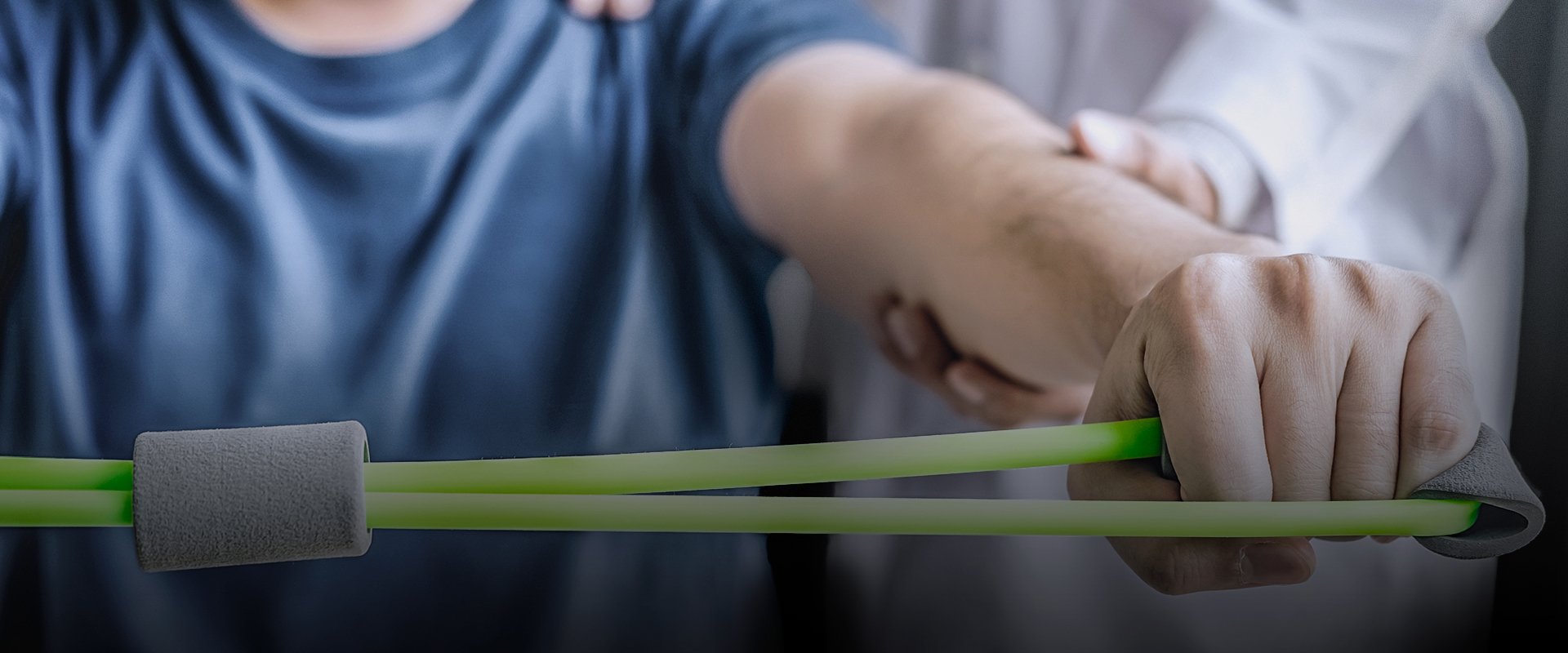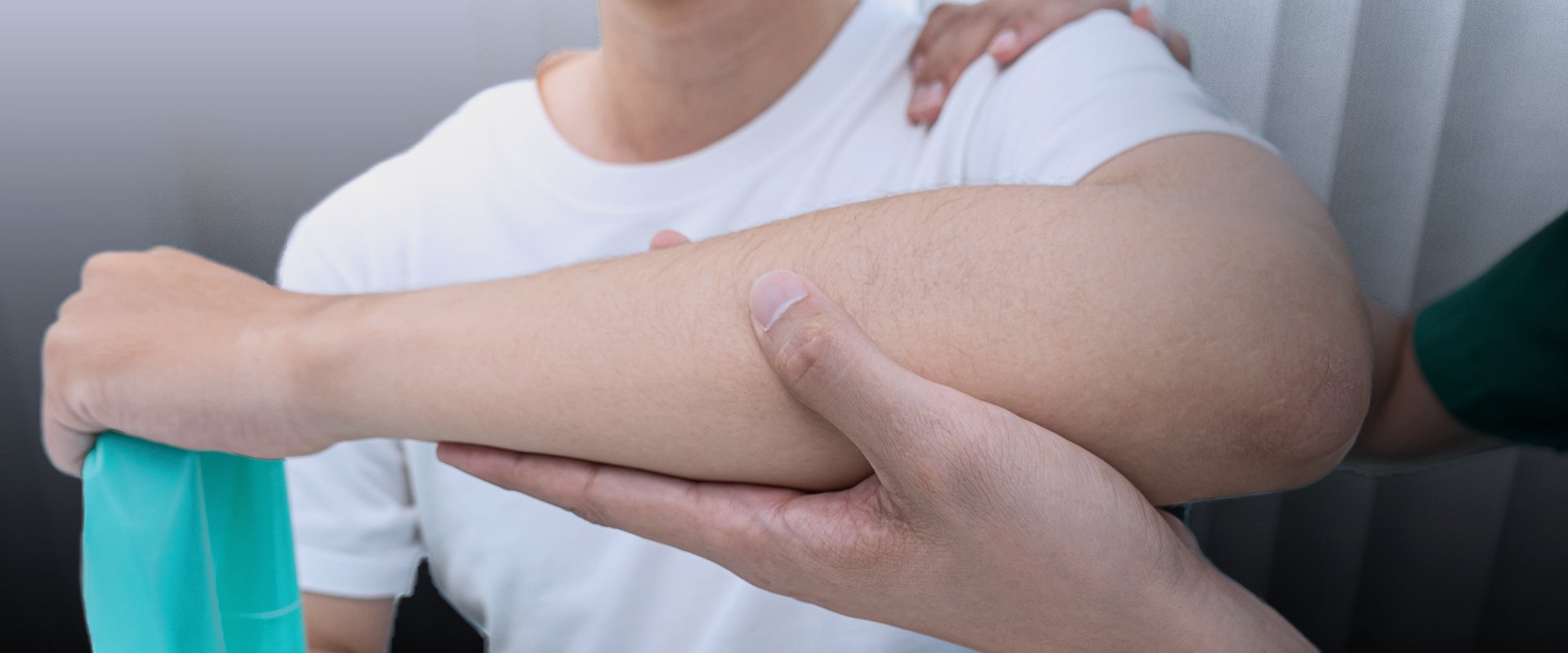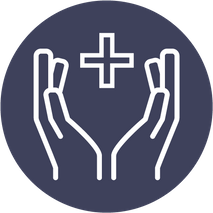
Physical Therapy for Arm rehab
AT EVOLVE
Physical Therapy for ARM REHAB
WHY CHOOSE PHYSICAL THERAPY FOR ARM REHABILITATION?
Physical therapists are movement experts trained to rehabilitate injuries and surgeries to the arm. They address pain, impairments, activity limitations and participation restrictions with the goal to improve an individual's function. Physical therapy is not a quick fix but addresses the underlying causes of your symptoms and promotes long-lasting solutions.
Your physical therapist will assess your arm and nearby areas, interview you about your arm symptoms and learn about the activities limited by these symptoms. This allows your therapist to create a comprehensive rehabilitation program that addresses underlying causes of pain and injury, restores tissue health and function and prepares your arm for return to normal activities.
WHAT DOES ARM REHABILITATION LOOK LIKE?
Physical therapy for an arm injury, a chronic arm issue or following arm surgery aims to relieve symptoms of pain, weakness or stiffness, help restore normal strength and range of motion and facilitate return to full activities. My team of therapists and I will start by getting to know your concerns and goals and performing a thorough physical exam to determine what areas we should target with our physical therapy interventions. Your therapist may employ manual therapy interventions to target joint and tissue mobility while also prescribing movements and exercises for strength, motor control and mobility which you will perform in the home and the clinic.
Following arm surgery, your surgeon may provide a post-surgical rehabilitation protocol that will guide your physical therapy program to promote healing while protecting the surgical site.
Common Arm Injuries and Arm Rehab
Arm injuries commonly treated by physical therapists include:
- Shoulder impingement
- Rotator cuff tears
- Arm muscle strains
- Carpal tunnel
- Tendonitis
- Tennis elbow
- Golfer’s elbow
- Biceps
- Fracture
- Osteoarthritis
- Bone spurs
- Shoulder dislocation
- Cubital tunnel syndrome
- Ligament sprain
Arm surgeries commonly rehabilitated by physical therapists include:
- Rotator cuff repair
- Shoulder labral repair
- Shoulder replacement
- Impingement surgery
- Acromioclavicular joint repair
- Bicep tendon repair
- Ulnar nerve decompression
- Elbow replacement
- Carpal tunnel release
- Wrist/hand tendon repair
- Fracture repair
HOW LONG DOES ARM REHABILITATION TAKE?
The duration of your rehabilitation plan of care will vary depending on the severity of your symptoms, whether you are recovering from or planning to undergo surgery, and the types of activities you aim to resume. While full resolution of symptoms can take some time, you may begin to see some results quickly. You should experience improvements in many symptoms such as pain, stiffness, and inflammation within a couple of weeks but returns in strength, flexibility and overall mobility may take longer. Achieving long-lasting results may take some time, but dedication to your program will not only help you achieve these results but also decrease the likelihood of symptoms recurring in the future.
UNDERSTANDING THE ARM
The arm consists of many complex structures–any of which could be injured or treated with surgery. The shoulder is a ball-and-socket joint supported and moved by the deltoid muscle, the rotator cuff and upper arm muscles like the biceps and triceps muscles. Tendons and ligaments surround the joint. Long muscles extend down the upper arm toward the elbow joint and move the shoulder and elbow. The elbow joint consists of the articulation of three bones–the humerus, ulna and radius. Many muscles attach and insert near the elbow and thus there are several tendons and ligaments nearby. The forearm consists of the radius and ulna bone which connect the elbow to the wrist bones and at least 15 muscles travel through this area.
As you can see, there are quite a few structures that physical therapists may treat in the arm. The location of the injury and the structures involved dictate the symptoms as well as the functional implications of the injury.
The bones can experience a fracture, the joints may be affected by conditions like osteoarthritis, sprains can affect the ligaments and strains and tendinopathies can affect the muscles and tendons throughout the arm. Some injuries can be pinpointed through careful clinical testing such as palpating for painful tissues or testing the muscles but in some cases imaging such as an x-ray, CT scan, ultrasound or MRI may be recommended for a clearer answer.
End Injury Progression
Physical therapy for arm rehab has proven to prevent injury, slow and even stop pain issues, improve performance, and reverse injury progression in many cases.
Relieve Pain
The movements used in this technique can target your entire body helping you to manage discomfort and pain during the course of your physical therapy treatments.
Improve Range of Motion
Posture awareness is an important area to focus on due to the fact that certain positions may cause you further discomfort and pain.
Restore Mobility
You can regain mobility and flexibility by taking part in the stretches and exercises as prescribed by your physical therapist.
How Long Will Physical Therapy for Arm Rehab Last?
If you decide to work with a physical therapist to help correct your arm issues, your entire arm rehab treatment plan could consist of around 8-20+ different physical therapy sessions that will each last 60-90 minutes. Once you complete your customized arm rehab physical therapy treatment plan, you will be able to continue to do the prescribed stretches and exercises utilized during your arm rehab PT sessions yet in the comfort of your own home.
WHAT SYMPTOMS DOES ARM REHABILITATION TARGET?
In addition to pain, arm rehabilitation targets impairments, activity limitations and participation restrictions related to your arm symptoms. To get a better understanding of what symptoms arm rehabilitation targets, continue reading
Body structure and function impairments:
- Weakness in the muscles around the shoulder, elbow, forearm or wrist
- Difficulty moving the arm in one or more directions
- Swelling anywhere in the arm
- Feelings of instability in the joints like the shoulder
- Loss of flexibility or range of motion in the shoulder, elbow or wrist
- Changes in joint mobility
- Numbness or tingling in arm or hand
Activity limitations and participation restrictions:
- Difficulty reaching overhead
- Inability to lift or carry heavy items
- Trouble manipulating tools or other items
- Difficulty with pushing or pulling
- Reduced ability to perform your work duties due to arm symptoms
- Inability to participate fully in athletics
- Interrupted sleep due to pain or discomfort
COMMON ARM REHABILITATION TREATMENTS USED BY PHYSICAL THERAPISTS
Your physical therapist will design an individualized treatment plan just for you based on the structures in your arm that need treatment, however, these are some of the more common rehabilitation interventions for the arm that you might experience when working with your PT:
Modalities and manual therapy techniques to the arm and surrounding areas reduce pain and inflammation and promote tissue healing
Bracing and taping: in some cases, bracing is used to protect healing tissues early in recovery or as you return to activity and taping can be used to manage swelling, and promote muscle relaxation or activation
Education about your injury, the stages of healing and what you can do to participate in your recovery and prevent future injury
Muscle strength, endurance, motor control and power training to improve stability, endurance, coordination and strength in the arm for return to normal activity
Tissue and joint mobilization, mobility and stretching techniques to restore normal range of motion and flexibility
Sport and work-specific training exercises to prepare the arm to return to your prior activities and limit the risk of future injury.
As you can see, physical therapists have a lot of treatments in their toolbox to rehabilitate the arm. If you have an injured arm, are undergoing arm surgery or are noticing uncomfortable symptoms in your arm, call us today to learn more about our services and schedule an evaluation
Mill Basin (located in Harbor Fitness)
6161 Strickland Ave
Brooklyn, NY 11234
Monday: 7am-8pm
Tuesday: 7am-8pm
Wednesday: 8am-5pm
Thursday: 7am-8pm
Friday: 8am-1pm
718.524.3261
Park Slope (located in Harbor Fitness)
550 5th Ave.
Brooklyn, NY 11215
Monday: 9am-8pm
Tuesday: 8am-6pm
Wednesday: 9am-8pm
Thursday: 8am-6pm
Friday: 8am-3pm
718.524.3261
Gravesend
372 Avenue U
Brooklyn, NY 11223
Monday-Thursday: 8am-8pm
Friday: 8am-3pm
Kings Highway
945 Kings Highway
Brooklyn, NY 11223
Monday-Wed.: 12pm-8pm
Ready to take the next step to a healthier you?
Contact Us Today!
PHYSICAL THERAPY FOR ARM REHAB
Need physical therapy for arm rehab?
Let our caring and compassionate physical therapists help you with relieving pain while getting you back on your feet comfortably.
Call now to schedule your first PT consultation free of charge.
Call: 1-718-524-3261







